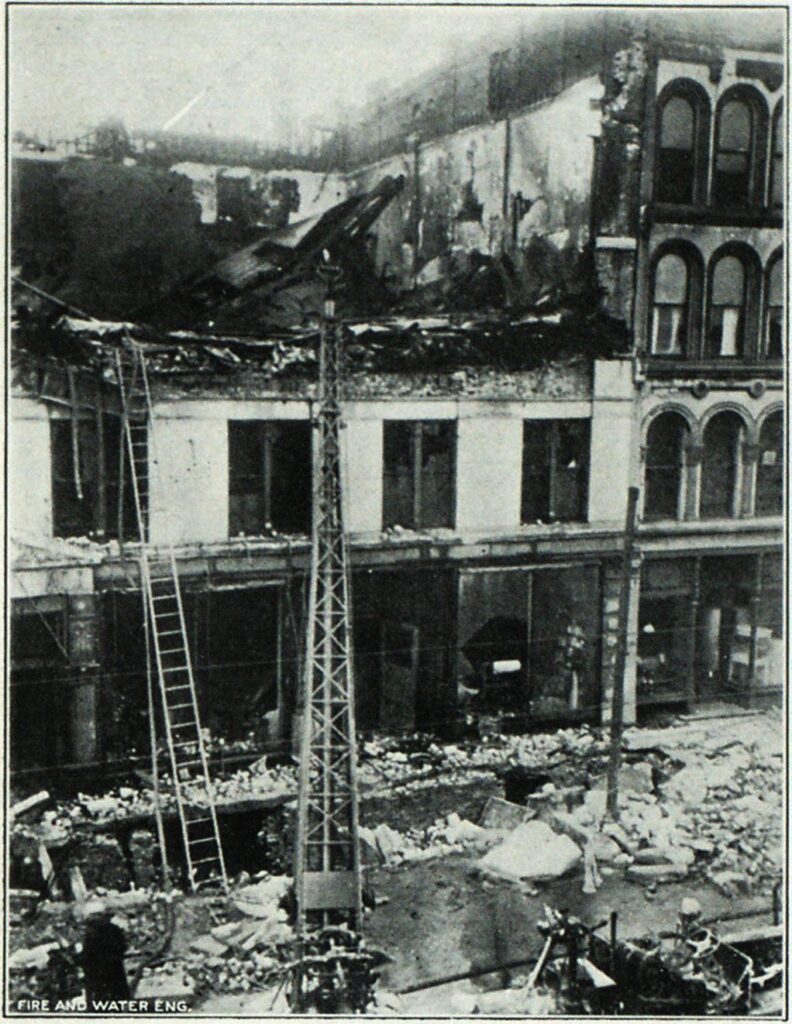Chicago Fire Takes Lives of Seven Firemen and Two Civilians

Wall of Old Curran Hall, Destroyed in Incendiary Fire, Collapses with Fatal Results—Several Firemen Also Injured—Fires of the Week
SEVEN Chicago firemen and two civilians are dead and a number of firemen severely injured following an explosion during a fire in Curran Hall, an ancient building in the Ghetto of Chicago, I11., on Friday, April 18. The men killed and injured, mostly members of Engine Company No. 5 and Truck Company No. 12, were caught either on the fire escape of the structure, on fire ladders against its front or upon water tower No. 1, which had been playing a stream on the burning building when the collapse came. The explosion, it is thought, was caused by a pocket of gas or a back draught and blew out the entire front wall of the structure, showering the heavy masonry on the men who were killed and injured. Those killed were Capt. Jack Brennan, 40, Engine Co. No. 5; Lieut. Frank Frosch, 37, Truck No. 12; Thomas Kelley, 51, Truck No. 12; Sam T. Warren. 40, Truck No. 12; Michael Devine. 34, Engine Co. No. 5; Frank Leavy, 37, Engine Co. No. 107, and Edward Kersting, Truck Co. No. 12.
Directly in front of the collapsed wall water tower No. 1, an apparatus which cost the city $30,000 had been pouring water on the fire and it was badly crushed by the mass of masonry which fell upon it, as will be seen by the illustration which heads this article.
Among the first to reach the scene after the alarm had been received was Battalion Chief Kerwin who was in charge of fighting the fire when the front wall of the building crashed. He was inside the building when he saw the ceiling begin to sway. In describing what followed he said:
“I feared what might happen. I immediately ordered all men out of the building. To remain any longer would uselessly endanger lives. We all left the building through the front windows. I stepped over to an adjoining building, as did other members of the department. But several firemen—I should say a half dozen or so—climbed down the fire escape. They were close to the second floor when the explosion came. It seemed to me that a gas pocket formed; I don’t know where. Its force was tremendous. The wall fell without warning. It bulged in the middle, then collapsed with a deafening roar. I think there were six men who were carried into the street, clear of the wall. But the others were trapped. They hadn’t a chance. There were at least five of these. The wall carried them down to the sidewalk and buried them under it. One of the members of Truck 12 was not so badly injured. But I understand that two of its members were instantly killed. Engine 5’s three men were, seriously injured. It would be impossible for me to say what caused the gas pocket to form until further investigation.”
As the enormous weight of wreckage came down when the upper wall on the Gray Avenue side of the structure caved outwards some of the men on the ladders and on the fire escapes were thrown clear, but the majority were buried with the collapse. So violent was the force of the falling stone that the sidewalk in front of. the structure was pulverized and stone and steaming brick were piled into the basement of the structure, carrying the dead and injured down with it. Through the mass of debris the arms and legs of the unfortunates could be seen. Perhaps more credit is due to John Sella, of Engine Company No. 5 than to anyone else for the quick rescue of the injured. He, pinioned in the debris with a ton or more of stone upon one arm and probably an equal weight across his left thigh, was conscious. In spite of his pain he shouted up to the rescuers the suggestion that the heavy stones be broken with sledges and lifted in pieces by block and tackle. Firemen, policemen and civilians were armed with 16-pound sledges and ropes were looped about the broken sections as soon as they were loosened and thus many of the larger pieces of debris were cleared away. At this time the one thought was to bring out those that were injured.
April 18 proved a heavy day for the Chicago fire department as, besides the fire just described two others of considerable magnitude occurred. One was in the stockyards and the other in a five-story building on Randolph Street. Fire Marshal Edward J. Buckley was superintending operations at the stockyard fire when he was summoned to take charge at the Curran Hall disaster.
Two men, tenants of Curran Hall. Leo Unell and Samuel Moore, were later arrested charged with arson. The testimony before the coroner’s jury was to the effect that these men. partners in the Leather Sporting CJoods and Novelty Company were in financial difficulties and it is alleged either set the fire or conspired to have it done, according to witnesses. Insurance to the amount of $43,000 was placed by an agent on the stock of the company which, it was asserted, was only worth $3,500. When the agent attempted to withdraw the policies Moore told him. according to the former’s story, that Moore’s wife had the policies and that he would get them for him the next day. The agent was again put off and in the mean time the fire occurred. Testimony bv firemen and eye witnesses, it was alleged, showed that inflammables had been spread over the second floor occupied by the leather company and down the rear and front stairways. According to Fire Lieutenant Thomas Fitzgerald, he had found wood alcohol in a tin in the ruins. The jury returned a verdict against both men of “murder by arson.” They were held for the grand jury.


